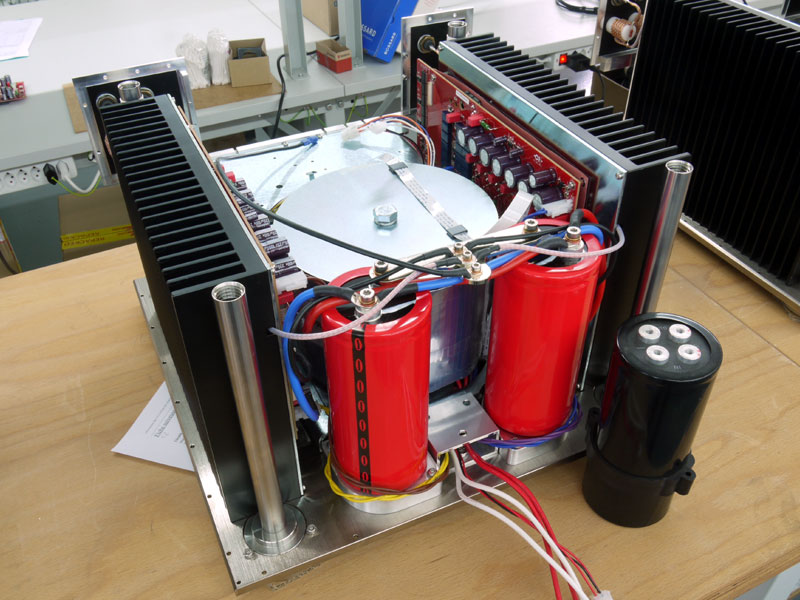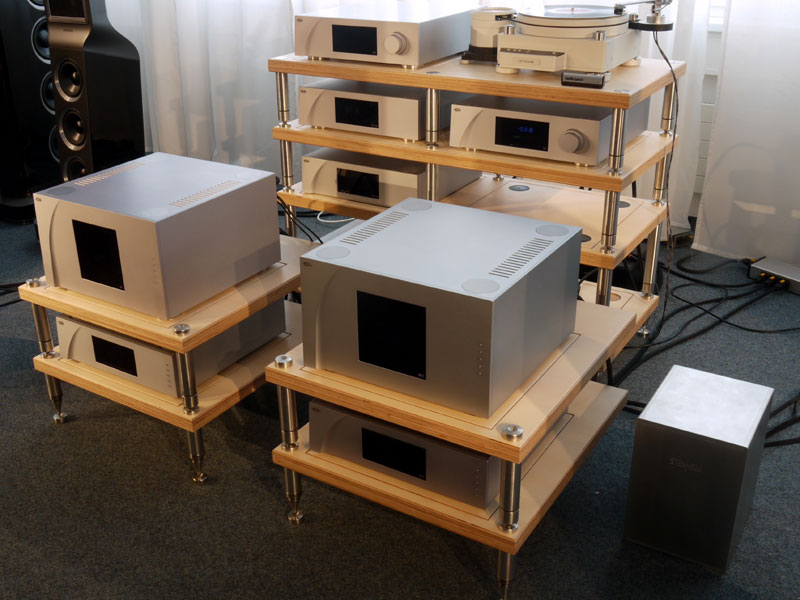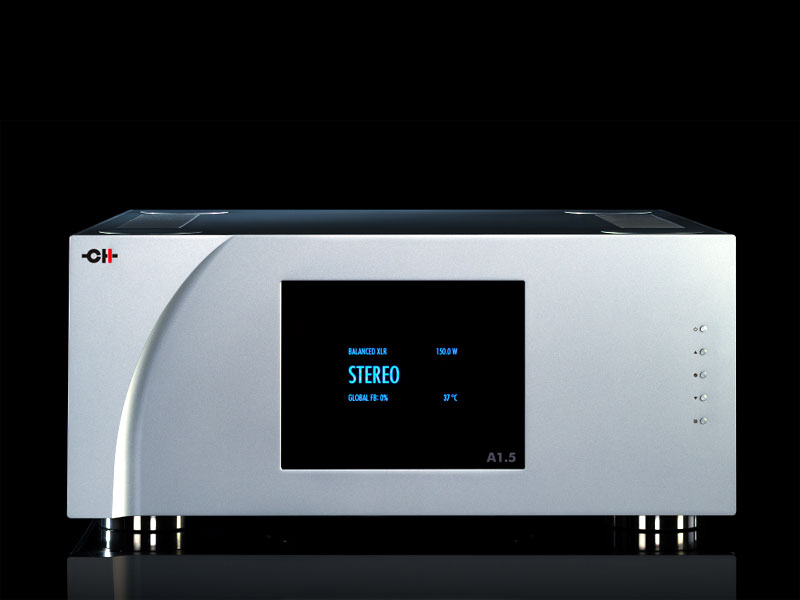CH Precision: An Upgrade and An Addition
hen it comes to solid-state amplification, CH Precision’s M1 is amongst the most impressive units to have recently come my way. Along with Naim’s Statement monoblocks, the M1 has served to shift both the performance goalposts and my own expectations, not least because of its clever, configurable topology. You need a load-tolerant stereo amp? You need an amplifier set up for biamping (one input, two identical outputs with individually adaptable damping factors)? You want a high-power bridged monoblock or a high-current monoblock to drive a truly awkward load? The M1 is or can be all of those things, making it uniquely adaptable to different (or changing) system circumstances. Combine that with excellent musical performance and you have an extremely tractable and attractive solution to a wide range of system demands. No surprise then that despite a price tag that goes well beyond merely reassuringly expensive -- $54,000 for a stereo amp, to be precise -- the M1 is firmly ensconced on my "highly recommended" list.
And things just got a whole lot better. No, sadly for non-Swiss readers, I can’t report that the Swiss franc has crashed to an all-time low. But I can reveal that CH Precision has instituted a significant change to the M1, one small step that has led to a giant leap in musical performance. It might seem odd to use the words both "small" and "significant" to describe this upgrade, but, in physical terms, it is both of those things. It only involves a single pair of capacitors; it’s just that those caps are the main reservoir caps and amongst the largest I’ve ever come across. The black-bodied capacitors used in the original amp have been replaced by the slightly larger red ones seen in the pictures. The scale is deceptive: what you need to keep in mind is that the M1 chassis is well on the way toward cuboid when it comes to its proportions, making each of those red bean cans well on the way toward 8" tall -- which in turn makes them large both in terms of capacity and price. The difference those red caps make is as obvious musically as it is visually. On a recent trip to Switzerland, I was able to listen to the latest M1 in direct comparison to one of the units I reviewed, on the same Stenheim Ultime Reference Passive loudspeakers. I arrived equipped with a whole collection of familiar material, carefully chosen to tease out the nuances and differences between the musical and expressive capabilities of the two amplifiers, but in practice I needn’t have agonized over the selection. The superiority of the new version was apparent even before the VSO played the opening bars of Beethoven’s First Piano Concerto. The Benedetti Michelangeli/Giulini recording (the SHM SACD [Deutsche Grammophon Gesellschaft UCGG-9044]) is a live performance, and as the mics come up you can hear the hall ambience and the audience noise. With the revised amplifier in the system, the sense and proportions of the space were much more apparent, the acoustic reaching deeper into the stage and forward to include the listener, who was now surrounded by living, breathing, shuffling and program-rustling compatriots. That drop in the noise floor and the increase in spatial coherence and resolution of low-level detail spoke volumes about the amplifier’s overall performance, points reinforced as soon as the band started playing. From the controlled tension and carefully restrained levels in the opening bars, to the string textures, air around the bass notes and the sheer brilliant fluidity of Michelangeli’s playing, this was a huge step forward in terms of musical and expressive range, a much better performance by a much better band.
For once, this improvement was more than simply a case of subjective or observational judgment. The new caps result in a power supply that is measurably more resistant to the disturbance of, and quicker to respond to, transient demands. Such behavior under the dynamic conditions imposed by a constantly varying musical signal is critical to musical performance, dynamic and rhythmic authority, all facets clearly apparent in the delivery of the modified amplifier. The end result was that the single revised M1 operating in stereo started to approach the agility and intimacy (if not the presence and bandwidth) of the active system employing two of the original amps. That’s a big step up in performance, sonically and musically, but, most important of all, in terms of the expressive connection between the system and the listener. If the raison d’etre of high-end audio is to put you in the presence of the original performers, to re-create the chemistry and emotional milieu of the original event, the M1 upgrade moves you that much closer -- and the amp will now do it on a wider range of recordings. But that’s not all, and for once the news just keeps getting better. The institution of the new caps in production coincided with a price increase from $51,000 for a stereo unit to the previously noted current price of $54,000. Earlier amplifiers can be upgraded to the new standard and, in order to avoid the logistical challenges, inconvenience, cost and the potential risk of damage associated with shipping large, heavy but delicate instruments back for service, this is an operation that will be carried out in situ, a CH-certified technician travelling to the owner’s home to complete the work with minimum disruption to listening pleasure. Arrangements (and costs) will be defined by local distributors, but in the US, where CH Precision runs its own distribution, the total cost of the upgrade will be $3000 per amplifier -- the same as the price increase in production units -- an upgrade price that includes the parts, labor and travel costs of the technician doing the work. That’s what I call looking after your installed customer base. Of course, $3000 isn’t exactly pocket change, but then the leap in performance that results from the capacitor upgrade is far from subtle. For any listener who already has something north of $50,000 invested in an amplifier, this is a bargain and a no-brainer, and it establishes a new paradigm in terms of service. Admittedly, the straight-swap nature of this upgrade makes it possible to carry out the work in-house, but with CH Precision’s modular topology and a little forward planning, in future it should be possible to make this approach the norm rather than an exception worthy of comment. CH Precision will start contacting US owners shortly, but if you want to make sure you are on the list (or just to try cutting the line) an e-mail to the company registering your interest wouldn’t go amiss.
Meanwhile, lurking at the back of the
CH Precision Batcave, I discovered another, potentially even more interesting animal.
Launched at the recent Hong Kong show, the A1.5 amplifier is a new addition to the CH
Precision range, stepping into the rather large slot between the A1 and M1 models.
Offering the same features and configurable topology, it neatly splits the difference in
terms of price ($39,500 for a stereo chassis, $75,000 for a pair of monoblocks) and power
(150 watts at 8 ohms). It also introduces a new chassis module that sits halfway in terms
of height between the A1 (which shares the same external dimensions as almost all the
other CH Precision products) and the double-height M1. To my eyes it’s the most
attractively proportioned amplifier in the range, more solid and authoritative in
appearance than the slim-line A1, more elegantly proportioned than the rather squat but
undeniably impressive M1. I didn’t get the chance to hear it, but the company
suggests that its performance splits the difference too, which, given the recent step up
in the M1’s delivery, makes it a very interesting prospect indeed. |



